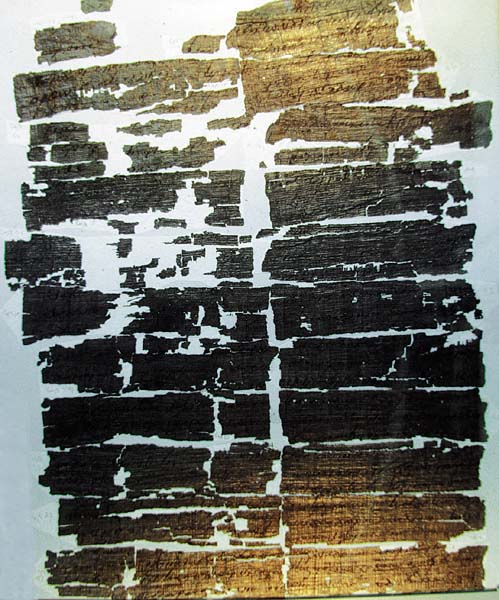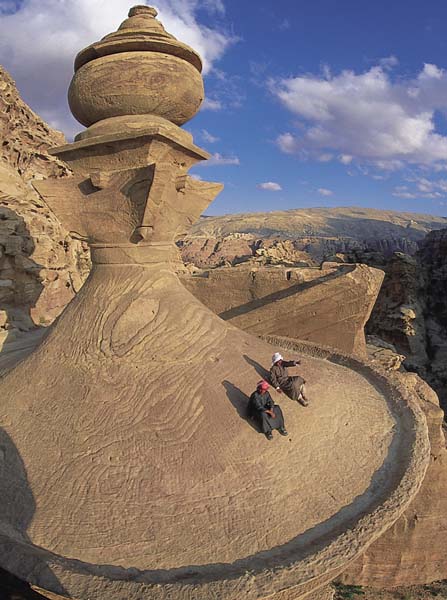
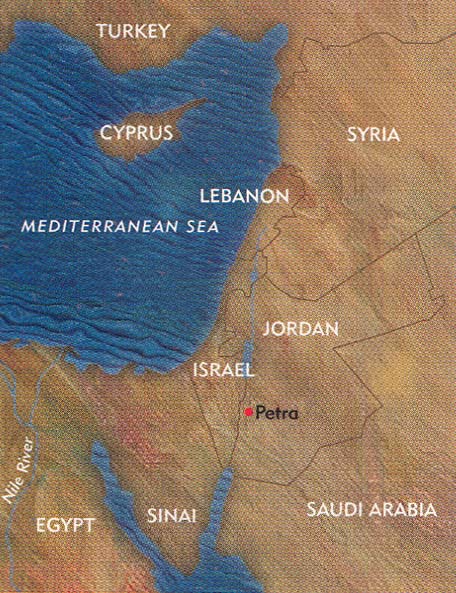
It seems no work of Man’s creative hand,
By labor wrought as wavering fancy planned;
But from the rock as if by magic grown,
Eternal, silent, beautiful, alone!
Not virgin-white like that old Doric shrine,
Where erst Athena her rites divine;
Not saintly-grey, like many a minster fane,
That crowns the hill and consecrates the plain;
But rose-red as if the blush of dawn
That first beheld them were not yet withdrawn;
The hues of youth upon a brow of woe,
Which man deemed old two thousand years ago,
Match me such a marvel save in Eastern clime,
A rose-red city half as old as Time.
John William Burgon (1813–1888)
Petra is easily one of the world’s most spectacular archaeological sites.1 Located in what is now the Hashemite kingdom of Jordan, the site’s famous tomb facades are carved into the magnificent red, pink and brown sandstone cliffs surrounding the Wadi Mousa, a seasonal riverbed. Visitors to Petra, awestruck by these gigantic tombs, might conclude that this was a city of the dead. At its height, however, Petra was the capital of a powerful kingdom populated by thousands of living souls. Indeed, this “rose-red” city remained a vital, thriving community for centuries.
Petra’s story may begin as early as the upper Paleolithic period (c. 40,000–10,000 B.C.). Stone tools have been discovered in the region that probably date to this time, when people lived as hunters and gatherers. More certain evidence comes from the later Neolithic period (c. 6,000–4,500 B.C.)—the era that saw a shift to agriculture and the domestication of animals. Neolithic tools, tombs and settlements have been found in the Petra valley; one of the most important Neolithic villages in the ancient Near East is located just a few miles north of Petra, at Beidha. Excavated in the 1950s and 1960s by the British archaeologist Diana Kirkbride, this extensive pre-pottery Neolithic site contains both round and square structures with rough fieldstone foundations, highly specialized stone tools, and evidence of agriculture (for example, grinding stones used to produce flour).2
During the late second millennium and early first millennium B.C., the Hebrew Bible tells us, the Petra region was part of the kingdom of the Edomites. According to long-held tradition, the Israelites passed through Petra on their way from Egypt to the Promised Land. A number of Petra’s most important geographical features are associated with Moses: The Wadi Mousa, the Riverbed of Moses, for example, is the main valley at Petra; and in Islamic tradition, Moses’ brother Aaron is said to be buried on Jebel Haroun, the Mountain of Aaron. During the reign of King David (tenth century B.C.), the Israelites attacked Edom, beginning a cycle of enmity that would last the entire history of the two kingdoms. This animosity continued for generations, even as the United Monarchy of the Israelites was replaced by the divided kingdoms of Israel in the north and Judah in the south. One of the kings of Judah, Amaziah (796–781 B.C.), was associated with a later campaign against the Edomites, as well as a particularly bloody event that, until recently, was thought to have taken place in Petra. According to 2 Kings and 2 Chronicles, Amaziah led a counteroffensive against Edomite raiding parties that had been marauding in his kingdom. He pushed them back into Edom, where they took refuge in a mountain fort called Sela (meaning the Rock; “Petra” is Greek for Rock). Amaziah slew 10,000 men while capturing the fort (2 Kings 14:7); then he threw the survivors of the siege off the mountain to their deaths (2 Chronicles 25:11–12). Early in this century, the massif of Umm el-Biyara, which overlooks the central Petra Valley on the west, was identified as a possible location of biblical Sela. Subsequent excavations on top of the plateau by the British archaeologist Crystal M. Bennett uncovered a small Edomite settlement there, but the earliest datable remains were from the seventh century B.C., a century after Amaziah,3 thus ruling out Umm el-Biyara as the site of Sela. Nevertheless, Bennett’s excavations proved Petra was inhabited in the Iron Age.
The most famous ruins at Petra, built centuries later, are associated with the kingdom of the Nabataeans. The origins of the Nabataeans are shrouded in mystery. They were perhaps originally seminomadic herdsmen and traders who penetrated the disintegrating Edomite kingdom from northwestern Arabia. Some of the earliest securely identified Nabataean sites are indeed from this region, such as ancient Hegra (Medain Saleh, in Saudi Arabia). The Nabataeans soon came to dominate the trade routes that were developing in the region, which made them wealthy and prosperous. And they made their capital at Petra.
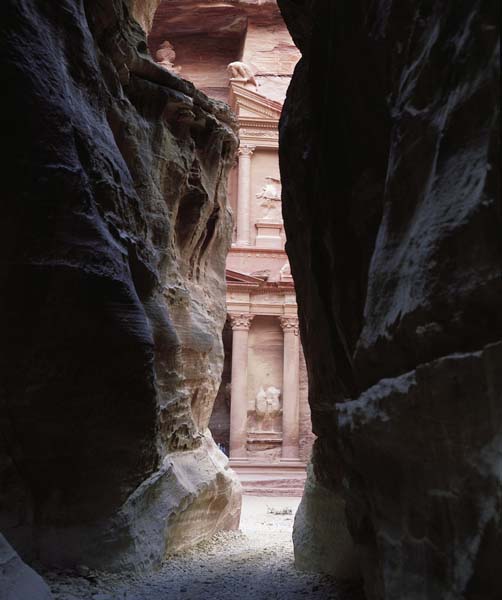
Petra commended itself as the Nabataean capital for several reasons. First and foremost, it is strategically located, dominating that part of the Rift Valley system known as the Wadi Araba (between the Gulf of Aqaba and the Dead Sea). This valley had long been an important trade route from the Gulf of Aqaba and northwest Arabia through the Jordan Valley to the Hauran (in Syria) and coastal Palestine. Petra was a kind of hub connecting sites such as Gaza, Aqaba (ancient Aila) and the north Arabian towns of Hegra and Jawf with Damascus in Syria. The Nabataeans’ domination of these trade routes resulted in their growing wealth and power. In the second and first centuries B.C., they became serious economic rivals of the major Levantine powers in the Hellenistic period: the Ptolemaic and Seleucid kingdoms (the southwestern and northeastern portions of Alexander the Great’s empire) and the Hasmonean kingdom (a Jewish kingdom, with its capital at Jerusalem, that comprised much of modern Israel).
Petra is not only strategically located, but also easily defended, since it is surrounded by steep sandstone cliffs and deep wadis. Petra is also relatively well-watered. This may come as a surprise to those who have seen the place, which appears at first glance to be nothing but desert. A number of important springs are located in the region, however, including one associated with Moses, the Ain Mousa. Moreover, the valleys catch runoff during the short rainy season. The Nabataeans took full advantage of this, constructing cisterns and reservoirs to trap rain water for agricultural use. Thus enough food was grown in the region around the city to support thousands of people.
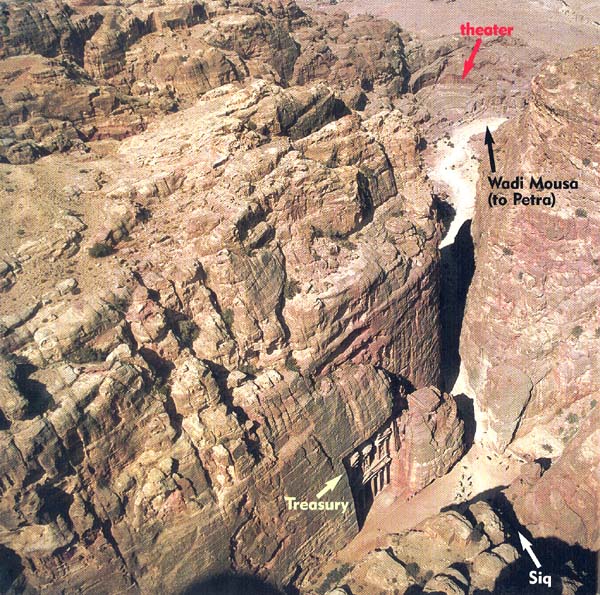
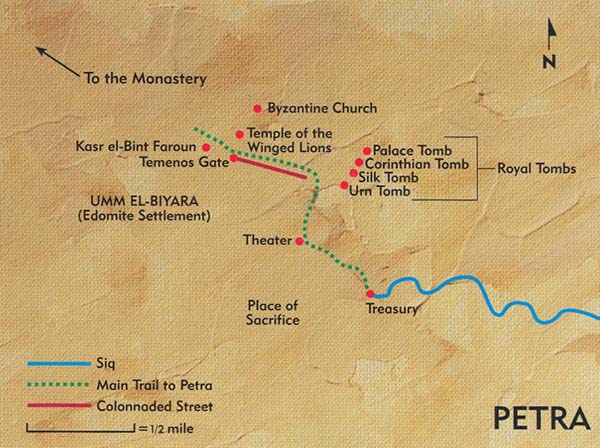
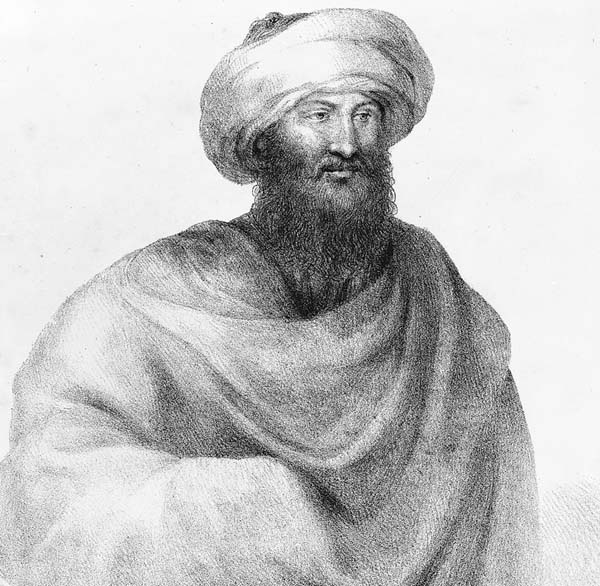
Originally, Petra seems to have been a rendezvous point and emporium for the seminomadic Nabataean tribes. This is suggested by the Roman historian Diodorus Siculus (first century B.C.). Diodorus did not write from firsthand knowledge, so we must take what he says about the barbarous Nabataeans with a large grain of salt. He did have access, however, to Seleucid historical accounts. The first historical episode associated with the site, according to Diodorus, involved the Seleucid king Antigonos I Monopthalmos (the One-Eyed), who in 312 B.C. sent his general Athanaeos to attack Petra to smash the growing Nabataean power. When Athanaeos arrived, he found that the menfolk were off trading, leaving Petra (described as a “rock,” unwalled but defensible) occupied mostly by old men, women and children. Athanaeos swooped in, seized goods worth over 500 talents (or three million drachmae, worth from 29,000 to 42,000 pounds of silver!)—a testament to the wealth of the Nabataeans, even early on—and promptly retired. When the men of the town returned and learned what had happened, they followed Athanaeos’s force and destroyed it.4 The Nabataeans regained their treasures and returned home. Later, Antigonos sent another general, Demetrios, against Petra; the Nabataeans simply packed up and left—another indication of their semi-nomadic ways—leaving a small defensive force in the “rock,” which managed to resist Demetrios until he could be bribed into abandoning the siege. Diodorus’s history seems to chronicle the rise of a nomadic trading people, who managed to gain a foothold in the region around Petra and could not be dislodged, not even by the armed might of the successors to Alexander the Great, the Seleucid Greeks.
By the middle of the second century B.C., the Nabataeans had established a traditional kingdom, with centralized authority and a capital at Petra. At its height, the Nabataean sphere of influence extended to Damascus in the north, Jawf in the east, Gaza in the west and Leuke Kome in the south. Their capital city had perhaps 30,000 inhabitants.5 During this period the Nabataeans carved most of their famous tomb facades at Petra and built many of the city’s other important monuments. The Nabataeans soon became so strong that they drew the attention of Rome, which by the second century B.C. was expanding into the Hellenistic Near East, and by 30 B.C. would control both the Seleucid and Ptolemaic kingdoms.
As the Romans turned their gaze eastward, the wealth and power of the Nabataeans naturally attracted them. Rome sent two separate armies against the desert nation—one commanded by Pompey in 63 B.C. and another during the reign of Augustus (31 B.C.–14 A.D.)—but these armies were unaccustomed to desert fighting (and were also susceptible to bribery by the Nabataeans). Eventually, however, the Nabataeans recognized that they could no longer resist the ever-growing might of Rome. In 106 A.D. the last Nabataean ruler, Rabbel II, allowed the kingdom to be annexed into the Roman Empire of Trajan. Reorganized into the Provincia Arabia, the regional capital was eventually moved to the Nabataean settlement at Bostra, in Syria. However, Petra continued to be an important city and was officially named a “metropolis” (a great city of the province) in the reign of Marcus Aurelius (161–180 A.D.). During the period of Roman domination, a number of important monuments were constructed in the city, and some others, like the famous Colonnaded Street, were remodeled.
With the advent of Christianity and the establishment of the Eastern Roman Empire (with its capital at Constantinople) in the fourth century A.D., Petra continued to flourish as a Byzantine city, and a number of important churches were added to the city’s monuments. However, several factors soon conspired to put an end to Petra’s prosperity. First, a series of devastating earthquakes wrecked key buildings. The most powerful one occurred in 363 A.D., but major quakes rocked Petra in later centuries, too. Second, a shift in trade routes—away from the south and Petra, in favor of routes up the Tigris and Euphrates valleys, through Dura Europos and Palmyra and on to Damascus—resulted in economic decline. Finally, with the rise of Islam in the seventh century, the region became a political, economic and cultural backwater, depopulated and forgotten as a great center of ancient Nabataean culture.

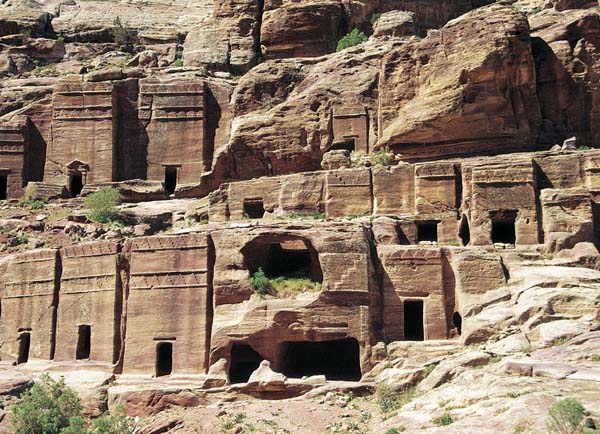
The end of Byzantine Petra was the end of Petra as a city in antiquity. Buildings were abandoned. In the Islamic world, the region was remembered only as the place of the shrine of Moses’ brother Aaron. The Crusaders built a few imposing castles in the area, but these, too, were soon abandoned as the region was left to Bedouin nomads. In the Western world, Petra simply passed out of memory. This was the state of affairs in 1812, when a 28-year-old Swiss explorer named Johann Ludwig Burckhardt set out from Tripoli, in Syria, on a journey to Cairo.
Burckhardt, the son of a Swiss officer in the French army, was educated at the University of Göttingen in Germany and sought to make his scholarly career in England. There he met Sir Joseph Banks, head of the Association for Promoting the Discovery of the Interior Parts of Africa, who convinced Burckhardt to carry on the work of the association. Since it was still somewhat perilous for Western Christians to travel in the Islamic world, Burckhardt went to Syria posing as a Muslim merchant from India named Ibrahim ibn-Abdullah. From there he was to embark on an overland journey to Cairo and thence to the African interior. In preparation, he studied Arabic, Muslim culture and Koranic law, and he was soon knowledgeable in all three.
On his journey south from Tripoli, Burckhardt entered Transjordan, where he began to hear local Bedouin tales of a magnificent city carved ages ago out of solid rock by magicians working for the Egyptian pharaoh. The city was located in the vicinity of the Tomb of Aaron and a valley called the River of Moses. Burckhardt, under the pretense of making a sacrifice at Aaron’s tomb (as a pious Muslim), was led to the city, which he explored as well as he could before his nervous guide (who doubted the trustworthiness of the local Bedouin) asked him to move on. He had seen enough, however, and his studies in ancient history made it possible for him to venture a guess as to the identity of the forgotten city: “It appears very probable that the ruins in Wady Mousa are those of the ancient Petra.” Burckhardt then pressed on to Egypt, where he converted to Islam, explored such sites as Abu Simbel and finally died of dysentery in 1817—without ever reaching the African interior. He is buried in the Islamic cemetery of Cairo and his grave marker bears his Arabic name, Ibrahim ibn-Abdullah.
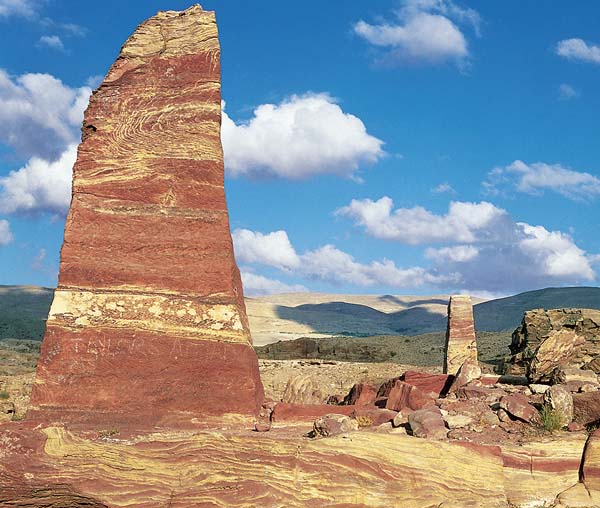
Other travelers followed, and descriptions of Petra, both verbal and pictorial, soon excited the Western imagination. By the end of the 19th century, the burgeoning science of archaeology would make its mark there.
Petra’s first explorers were understandably most interested in the magnificent tomb facades of the Nabataeans—the celebrated Khasneh el-Faroun (Treasury of the Pharaoh) at the end of the canyon-like Siq, the massive Deir (Monastery) in the mountains overlooking the city, and the so-called Royal Tombs (the Urn, Silk, Corinthian and Palace tombs). Indeed, the prevalence of these carved and rock-hewn tombs—hundreds of them clustered in the hills and cliff sides—prompted some to think of Petra as a huge necropolis: a city of the dead, peopled only by corpses and perhaps the priests who attended them.6
In the last few decades, however, most of the archaeological work has been done not in the necropolis area but in the so-called central valley, through which the Wadi Mousa runs after exiting the narrow gorge of the Siq. The evidence here is clear: This central valley region was a city of paved and colonnaded streets, shops, marketplaces, gardens, theaters, temples and, most importantly, houses—this was a city of the living.
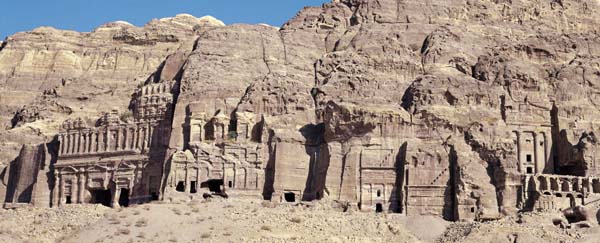
The visitor to Petra typically enters the site by proceeding down the canyon-like Siq to the Khasneh tomb facade, then emerges into a wider canyon where the city’s main theater was carved into a cliff face. Then, turning west, below the shadow of Jebel Khubtha and the Royal Tombs, the visitor enters the central valley. Here the Wadi Mousa runs east-west into a wide open space, with rocky slopes flanking it on the north and south. On these slopes are clustered the main buildings of the great city, dating to the Nabataean period (second century B.C. to first century A.D.), the Roman period (second and third centuries A.D.) and the Byzantine period (fourth to seventh centuries A.D.).
The main artery of the city was the so-called Colonnaded Street, a 20-foot-wide roadway paved with marble slabs, running east-west above the south bank of the wadi. Columns lined the street on either side (at least along its eastern half), perhaps to support a roof for covered sidewalks. The street was originally explored by Diana Kirkbride, excavator of the Neolithic town at Beidha, but later excavations by British archaeologist Peter Parr suggest that it was built sometime during the first century A.D. or shortly thereafter. Parr also discovered evidence of an earlier road, from perhaps the first century B.C.7
At the eastern end of the road, a number of shops have been excavated by archaeologist Zbigniew Fiema of the American Center of Oriental Research (Amman).8 Perhaps built as early as the first century A.D., these shops passed through several phases of redesign and reuse right up to the Byzantine period. Indeed, a cross has been cut into a door-post of one of the shops, clear evidence that the buildings continued to be used into the Christian era. Also in this area of the street, between the north sidewalk and the wadi, was the Nymphaeum, a kind of elegant fountain commonly found in Roman-period settlements. Opposite the Nymphaeum, on the south side of the street, a broad monumental staircase led to a plateau traditionally called the Upper Market, although there has been little archaeological exploration here and its true function is unknown. At the foot of the staircase was a triumphal arch, erected in the Roman period. It bore an inscription from the reign of Marcus Aurelius identifying Petra as a metropolis.
At the other end of the Colonnaded Street, another monumental staircase leads from the south sidewalk up to the courtyard of a structure traditionally called the Great Temple—actually a complex of structures, including a majestic paved temenos (a sacred courtyard) of over 2,500 square feet flanked by colonnades decorated with elephant-headed capitals. On an upper temenos terrace stands the main building, which has been excavated since the early 1990s by archaeologist Martha Sharp Joukowsky and her team from Brown University.9 The main building is a massive affair, containing a spacious portico decorated with sculpted limestone busts and marble theater masks. Four huge columns support magnificently carved floral capitals.
Early in the 20th century, the German scholars Walter Bachmann, Carl Watzinger and Theodor Wiegand identified this complex as a temple. However, the Brown University team has discovered that at some point—perhaps in the first or second century A.D.—the earlier parts of the building (dating to as early as the first century B.C.) were modified, and a theater-like seating complex was added to the central part of the structure. Preliminary analysis of architectural features discovered during the 1999 season suggests that the stage of the theater is a still later addition and that for some time the theater existed without a stage. Perhaps the Great Temple was modified into a sacred theater, like the one at Birketein (near Jerash, north of Amman), and then later into a conventional theater.10 There is ample evidence for reuse of the site in the Late Roman and Byzantine periods as well: Rebuilt walls and features constructed with reused architectural elements from the temple can be found in both the lower and upper temenoi; and at some point late in the history of the lower temenos, the east colonnade area was used as a lime kiln installation. There is also evidence that a late bath complex was built into the west colonnade and that the orchestra of the central theater was used to store ashlar blocks for later construction. More excavation will be needed, however, before we can understand the various functions of this highly enigmatic structure throughout its history.
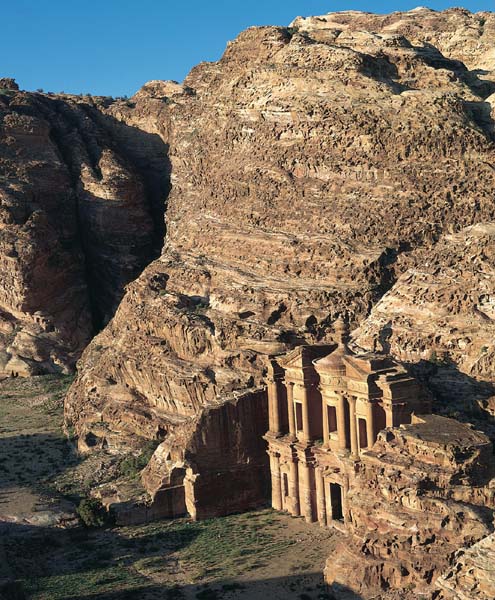
To the east of the Great Temple complex is the so-called Lower Market area, interpreted by earlier explorers like Bachmann, Watzinger and Wiegand as a marketplace or forum. Indeed, the whole terraced complex south of the Colonnaded Street was regarded by early archaeologists as a number of markets, or souks. However, recent excavations in this area by Leigh-Ann Bedal of the University of Pennsylvania have uncovered a magnificent ornamental pool, perhaps with a garden to the north.11 This kind of garden and pool arrangement, sometimes called a paradaisos, was often part of a palace complex or civic center in Hellenistic and Roman cities. This discovery calls into question the traditional market interpretation and suggests how much more we have to learn about Petra’s central city.
At the end of the Colonnaded Street, adjacent to the bath complex, is the famous Temenos Gate, a triple archway modeled, seemingly, after Roman triumphal arches.12 A magnificent demonstration of how the Nabataeans combined Greco-Roman ideas with local design elements, the gate was decorated with sculpted busts and perhaps bore inscriptions. Free-standing columns stood before the east facade; engaged columns elaborated the west. The date of this structure is still under debate. It is sometimes dated to the Severan period (193–211 A.D.) because this is the period of the earliest known triple arch with detached columns. However, the archaeological evidence suggests that the Temenos Gate was contemporaneous with the construction of the Colonnaded Street—so perhaps the Petra arch was based on earlier now-lost triple arches, like the Arch of Trajan in Rome which is postulated (by some) to have had three gateways.13 Trajan (98–117 A.D.) annexed the Nabataean kingdom to Rome and may have been honored by Petra’s new Roman citizens with an arch emulating the one he had already built in the imperial capital.
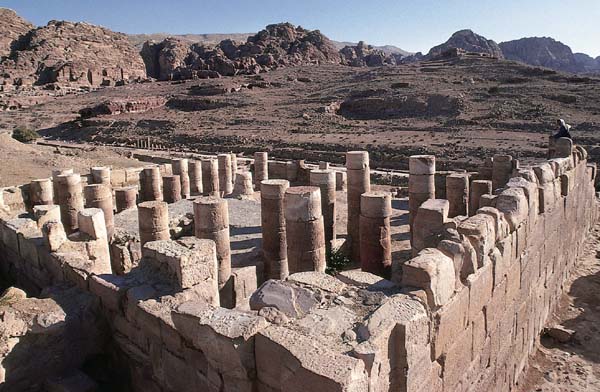
The Temenos Gate functioned, however, not as a triumphal arch but as a gateway to the sacred precinct of the greatest of Petra’s temples, the Kasr el-Bint Faroun (Palace of the Pharaoh’s Daughter).14 A paved courtyard nearly 500 feet long culminates in a massive structure of cut sandstone—probably constructed in the first century B.C., either after or as part of the building program of the great Nabataean king Obodas III (30–9 B.C.). The temple itself, which measures almost 5,000 square feet, is built on a foundation of solid bedrock and is thus relatively well preserved, despite Petra’s many devastating earthquakes. Four massive facade columns were flanked by antae (protruding wings of the exterior side walls), forming a deep porch. The cella (holy-of-holies), in back is divided into three rooms, and staircases lead to a mezzanine level above. A frieze of Greek-style triglyphs and metopes of the Doric order is overhung by a heavy cornice more in keeping with the Ionic-Corinthian order. Here, again, we see the Nabataeans freely combining Greco-Roman, Near Eastern, Egyptian and native ideas in the construction of their magnificent temple, which dominated the center of the city.
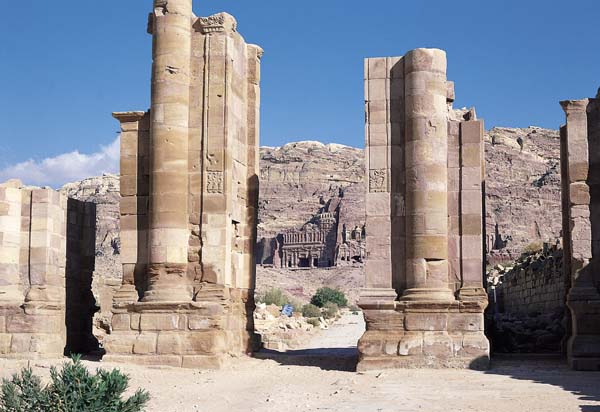
North of the Wadi Mousa were a number of important building complexes as well, marching up the side of the rise. Bridges linked the north and south banks of the wadi—several of the platforms for the arches that supported the bridge span are extant. The most important Nabataean structure on this side of the wadi is the famed Temple of the Winged Lions, excavated by Philip Hammond of the University of Utah.15 A much smaller temple than the Kasr el-Bint Faroun, it is of the more traditional “box-in-a-box” Nabataean type (consisting of a central altar surrounded by a screen wall), like the temples at Wadi Rumm, Khirbet Tannur and Khirbet edh-Dharih. It was nonetheless a very important structure, surrounded by a complex of courtyards, storage magazines and workshops. Clearly the building, the earliest major components of which date to the first century B.C., was part of a burgeoning temple economy. It is called the Temple of the Winged Lions because limestone capitals decorated with winged lions or griffins were discovered there. A “block idol”—a block of stone decorated with a human face—was also recovered from the ruins; it may be a cultic object dedicated to the Nabataean goddess al-Uzza (commonly associated with the Greek goddess Aphrodite and the Syrian goddess Atargatis).
Some of Petra’s important Christian remains are also on the north slope of the wadi. Of mostly Byzantine date, these buildings include a spectacular church, decorated with some of the finest mosaics yet discovered in Jordan, and a baptistery. Excavated by the American Center of Oriental Research (first directed by the late Kenneth Russell, and then by Pierre Bikai, the current director of the American Center of Oriental Research in Amman, and currently by Zbigniew Fiema), the richness of this edifice is not the only testament to the prosperity of the Christian population at Petra. In an ancillary storeroom, a cache of papyrus scrolls was recovered. These may prove to be among the most important Late Antique documents ever discovered in the Holy Land.16 Only partially deciphered (due to the extensive nature of the archive and the need for further preservation work on the papyri), the scrolls have already revealed that Byzantine Petra was a thriving city—not the dying backwater it was previously thought to be (see the second sidebar to this article).
The discovery of another church (the so-called Ridge Church), located at the very top of the wadi’s north slope, along with a number of domestic structures that have only recently been found by Patricia Bikai and the American Center of Oriental Research, indicates that this region was an important part of the central city into Late Antiquity.
Probably the most important recent evidence that Petra was a city of the living comes from excavations at az-Zantur, a rocky outcrop that overlooks the southern valley of the Wadi Mousa. Here, the Swiss-Liechtenstein expedition, under the direction of Rolf Stucky and Bernhard Kolb, discovered several houses—villas, really—that tell us much about the domestic architecture of Petra’s elites.17 The earliest phases of these houses date to the late second or first centuries B.C., and later phases continue to the fourth century A.D., when the series of devastating earthquakes began. At least one of the villas was decorated with elaborate interior frescoes in a kind of local version of the Second Style of Pompeian wall painting—characterized by depictions of architectural elements that create the illusion of real structures—while others had paved courtyards and peristyles, columns decorated with limestone Corinthian capitals and molded plaster architectural decorations. The small finds include fine pottery, coins, mosaic glass and engraved gems.
The excavations in the city center area of Petra, along with exploration of suburban areas and urban infrastructure (houses and villas in nearby Wadi Mousa village, pottery kilns, hydraulic systems, city dumps), make it abundantly clear that the old-fashioned vision of Petra as a stately necropolis must be abandoned. Since the advent of scientific excavations in the central valley under Parr and Kirkbride, modern archaeology has painted a picture of a bustling city—Nabataean, Roman, Byzantine—inhabited by thousands of people, containing streets and shops, high places and civic buildings, fountains and nymphaea, baths and theaters, cisterns and aqueducts, gardens and fora, towers and city walls, temples and churches.
People lived at Petra for thousands of years, from hunter-gatherers and the first agriculturists to the founders of the Edomite and Nabataean cultures and the subjects of the Roman and Byzantine empires. The living Petra is indeed a “rose-red city half as old as Time.”
I must thank Martha Sharp Joukowsky, director of the Brown University expedition, for the opportunity she gave me to be part of this important and exciting project.
MLA Citation
Endnotes
Scholarship on Petra is extensive. Comprehensive bibliographies can be found in Martha Sharp Joukowsky, Petra Great Temple, Volume I: Brown University Excavations, 1993–1997 (Providence: E.A. Johnson, 1998), pp. xvi-xxxiv; Lina Nehmé, Provisional Bibliography on Petra and the Nabataeans (Paris: ERA 2000 CNRS, 1994); Judith McKenzie, The Architecture of Petra (Oxford: Oxford Univ. Press, 1990), pp. 173–180; D. Homès-Fredericq and J.B. Hennessy, Archaeology of Jordan, Vol. I (Leuven: Peeters, 1986); Avraham Negev, Tempel, Kirche, und Zisternen, Ausgrabungen in der Wüste Negev (Stuttgart: Calwer, 1983), pp. 250–254. The best introduction to the site for the general reader in English is still Iain Browning, Petra (London: Chatto & Windus, 1982).
See Diana Kirkbride, “The Excavation of a Neolithic Village at Seyl Aqlat, Beidha, Near Petra,” Palestine Exploration Quarterly 92 (1960), pp. 136–145; and “Beidha: Early Neolithic Life South of the Dead Sea,” Antiquity 42 (1968), pp. 263–274.
See Crystal M. Bennett, “Umm el-Biyara—Pétra,” Revue biblique 71 (1964), pp. 250–253; “Des fouilles à Umm el-Biyarah: Les Edomites à Pétra,” Bible et Terre Sainte 84 (1966), pp. 6–16; and “Fouilles d’Umm el-Biyara. Rapport préliminaire,” Revue biblique 73 (1966), pp. 372–403.
See Negev, “Die Nabatäer,” Antike Welt, supp. to vol. 7 (1976), pp. 1–80; “The Nabataeans and the Provincia Arabia,” Aufsteig und Niedergang der römischen Welt vol. II no. 8 (1977), pp. 520–686; “Petra,” in Encyclopedia of Archaeological Excavations in the Holy Land, vol. IV (New York: Simon & Schuster, 1993); “Nabatéens et Byzantins au Negev,” Le Monde de la Bible 19 (1981). It is important, however, not to oversimplify Negev’s very important contributions to Nabataean studies, and his theories regarding the relationship between Petra and the Nabataean sites of the Israeli Negev.
See Kirkbride, “A Short Account of the Excavations at Petra in 1955–1956,” Annual of the Department of Antiquities of Jordan 4–5 (1960), pp. 117–122; Peter Parr, “Excavations at Petra, 1958–1959,” Palestine Exploration Quarterly 12 (1960), pp. 124–135. Unfortunately, no final report has been written in either of these excavations.
See Zbigniew Fiema, “The Roman Street in the Petra Project,” Annual of the Department of Antiquities of Jordan 42 (1998), pp. 395–424.
For a full bibliography of the Great Temple excavations to 1998, see Joukowsky, Petra Great Temple, pp. xxxv-xxxix. Yearly reports appear in the Annual of the Department of Antiquities of Jordan and in the “Archaeology in Jordan” feature in the American Journal of Archaeology.
For sacred theaters in the Near East, see Arthur Segal, Theaters in Roman Palestine and Provincia Arabia (Leiden: Brill, 1995). For other ideas on the function of the Great Temple, see Joukowsky, Petra Great Temple, pp. 125–128; Joseph Basile in Joukowsky, Petra Great Temple, p. 206; Erika Schluntz in Joukowsky, Petra Great Temple, pp. 220–222; and Schluntz, From Royal to Public Assembly Space: The Transformation of the “Great Temple” Complex at Petra, Jordan, Ph.D (Brown Univ. 1999).
See Leigh-Ann Bedal, “A Paradeisos in Petra: New Light on the ‘Lower Market’,” Annual of the Department of Antiquities of Jordan 43 (1999).
See Kirkbride, “A Short Account of the Excavations at Petra in 1955–1956,” Annual of the Department of Antiquities of Jordan 4–5 (1960), pp. 117–122; Peter Parr, “Excavations at Petra, 1958–1959,” Palestine Exploration Quarterly 12 (1960), pp. 124–135. Unfortunately, no final report has been written in either of these excavations.
For a full bibliography of the Kasr el-Bint Faroun, see McKenzie, Architecture of Petra, pp. 135–136.
Summarized in Philip Hammond, The Temple of the Winged Lions, Petra, Jordan: 1974–1990 (Fountain Hills, AZ: Petra Publishers, 1996).
See Fiema, “The Petra Project,” American Center of Oriental Research Newsletter 5 (1993), pp. 1–3; and “Une église byzantine à Pétra,” Archéologia 302 (1994), pp. 26–35. The scholarly literature on this important monument (and the papyrus scrolls) is just now taking shape.
For the excavations until 1992, see Andrea Bignasca Rolf A. Stucky, Petra—Ez Zantur I., and Ergebnisse der Schweizerisch-Liechtensteinischen Ausgrabungen: 1988–1992 (Mainz: Philipp von Zabern, 1996). For 1993 to the present, see the annual reports in Annual of the Department of Antiquities of Jordan (in English).






